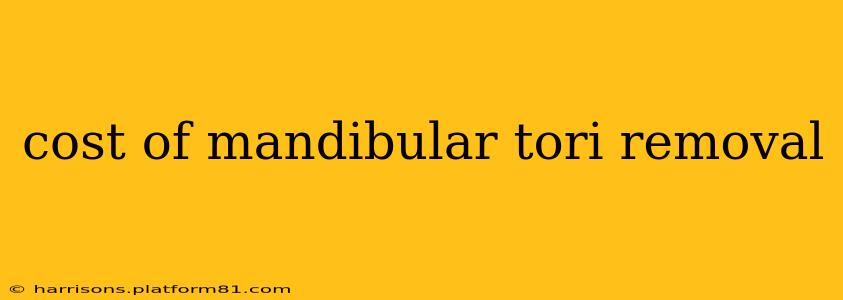Mandibular tori, those benign bony growths on the inner surface of the mandible (lower jaw), can cause discomfort or interfere with dental procedures. If removal is necessary, understanding the associated costs is crucial. This guide will break down the various factors influencing the price of mandibular tori removal, helping you budget effectively and make informed decisions.
What Factors Determine the Cost of Mandibular Tori Removal?
The cost of removing mandibular tori is highly variable and depends on several interconnected factors:
-
Geographic Location: Costs significantly vary across different regions and even within the same city. Areas with a higher cost of living typically have higher dental fees.
-
Dentist's Experience and Specialization: An experienced oral surgeon specializing in this procedure may charge more than a general dentist performing the same surgery. The surgeon's reputation and demand also play a role.
-
Complexity of the Procedure: The size, number, and location of the tori greatly influence the surgery's complexity and duration. Larger or multiple tori require more time and effort, increasing the overall cost. The presence of impacted teeth or other complicating factors also adds to the expense.
-
Anesthesia Type: The type of anesthesia used—local anesthesia, IV sedation, or general anesthesia—directly impacts the price. General anesthesia is typically the most expensive option.
-
Facility Type: The procedure's location (e.g., a private dental practice, an oral surgery center, or a hospital) also affects the overall cost. Hospital-based procedures generally come with higher fees due to overhead costs.
-
Post-Operative Care: Costs associated with post-operative care, such as follow-up appointments, medications, and any necessary complications management, are additional expenses to consider.
-
Insurance Coverage: Dental insurance plans vary greatly in their coverage for this procedure. Some plans may cover a portion of the cost, while others may not cover it at all. It's essential to check your specific policy's details before proceeding.
How Much Does Mandibular Tori Removal Typically Cost?
Providing an exact cost is impossible without knowing the specifics mentioned above. However, based on various sources, the total cost can range from a few hundred dollars to several thousand dollars. The lower end of the spectrum typically represents simpler cases with local anesthesia in locations with lower dental costs, while the higher end accounts for complex surgeries requiring general anesthesia, specialist care, and potential complications.
What is included in the cost?
The overall cost typically includes:
- Consultation Fee: An initial consultation to assess the tori and discuss the procedure.
- Surgical Fee: The fee for the actual surgical removal of the tori.
- Anesthesia Fee: The cost of anesthesia, if used.
- Radiographs: X-rays to evaluate the tori and surrounding structures.
- Post-Operative Instructions and Follow-up: Guidance on post-operative care and scheduling of follow-up appointments.
What is not usually included?
- Medications: Prescribed pain relievers or antibiotics.
- Laboratory Fees: If any tissue samples need to be sent to a lab for analysis.
Are There Alternatives to Surgical Removal?
While surgical removal is the most common solution, in some cases, patients may choose to leave the tori untreated if they are asymptomatic and do not cause any problems. However, if the tori are causing discomfort or interfering with dentures or other dental work, surgical removal is often the preferred option.
How Can I Find Affordable Mandibular Tori Removal?
- Compare Prices: Contact multiple dental offices to compare costs and services.
- Check Insurance Coverage: Understand your dental insurance coverage before scheduling the procedure.
- Payment Plans: Inquire about payment plans or financing options offered by dental practices.
- Look for Discounts: Some dental offices may offer discounts for cash payments or specific services.
This information is for general knowledge and should not be considered medical advice. Always consult with a qualified dental professional for personalized advice and treatment options. Getting multiple opinions can help you find the most appropriate and cost-effective solution for your specific situation.
